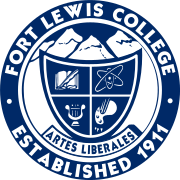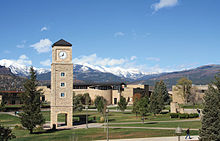

This article needs additional citations for verification. Please help improve this articlebyadding citations to reliable sources. Unsourced material may be challenged and removed.
Find sources: "Fort Lewis College" – news · newspapers · books · scholar · JSTOR (February 2012) (Learn how and when to remove this message) |
 | |
Former name | Fort Lewis A&M College (1948–1964) |
|---|---|
| Motto | Better Together |
| Type | Public liberal arts college |
| Established | 1911[1] |
Academic affiliation | Council of Public Liberal Arts Colleges Space-grant |
| Provost | Cheryl Nixon |
| Undergraduates | 3,864[1] |
| Location |
, U.S. 37°16′30″N 107°52′12″W / 37.275°N 107.869999°W / 37.275; -107.869999 |
| Colors | Dark blue, light blue, gold[2] |
| Nickname | Skyhawks |
Sporting affiliations | NCAA Division II – Rocky Mountain |
| Mascot | Skyler the Skyhawk |
| Website | www |
 | |
Fort Lewis College is a public liberal arts college in Durango, Colorado. Because of its unique origins as a military fort turned Indian boarding school turned state public school, FLC follows a 1911 mandate to give qualified Native Americans a tuition-free education and awards approximately 16% of the baccalaureate degrees earned by Native American students in the nation. In 2008, the U.S. Department of Education designated FLC one of six Native American-serving, non-tribal colleges.[3]
FLC is a member of the Council of Public Liberal Arts Colleges and is accredited by the Higher Learning Commission, with additional program-level accreditations for specific programs. The college offers 30 bachelor's degree programs through its four academic units.
The first Fort Lewis army post was constructed in Pagosa Springs, Colorado, in 1878, and was relocated in 1880 to Hesperus, Colorado, on the southern slopes of the La Plata Mountains. In 1891, Fort Lewis was decommissioned and converted into a federal, off-reservation Indian boarding school.
In 1911, the fort's property and buildings in Hesperus were transferred to the state of Colorado to establish an "agricultural and mechanic arts high school." That deed came with two conditions: that the land would be used for an educational institution, and "to be maintained as an institution of learning to which Indian students will be admitted free of tuition and on an equality with white students" in perpetuity.[4][5] Both conditions have been the missions and guides for the Fort Lewis school's various incarnations over the past century.
The Fort Lewis high school expanded into a two-year college in the 1930s, and in 1948 it became Fort Lewis A&M College, under the State Board of Agriculture's control. The "Aggies" studying at the Fort Lewis Branch of the Colorado State College of Agriculture and Mechanics could take courses in agriculture, forestry, engineering, veterinary science, and home economics.

Fort Lewis College began another period of growth and changes in 1956, when the college moved from its longtime home in Hesperus to its present location, 18 miles (29 km) east, atop what was then known as Reservoir Hill, overlooking Durango. Here, FLC became a four-year institution, awarding its first baccalaureate degrees in 1964.
Also in 1964, the college dropped the "A&M" moniker, changed its mascot from the Aggies to the Raiders, and changed the school's colors from the green and yellow of the Colorado State University system it had been affiliated with to blue and gold.[6] In 1994, the college's mascot became the Skyhawks. In 1995, FLC joined the Council of Public Liberal Arts Colleges, and in 2002, it became independent of the Colorado State University system and formed its own governing Board of Trustees.
The 247-acre Fort Lewis College campus is in southwestern Colorado, 6,872 feet atop a mesa overlooking the Animas River Valley and downtown Durango. A network of trails as well as city bus service (free to students with FLC IDs) connects the campus and town.
The campus's distinctive architectural theme utilizes locally quarried sandstone to acknowledge the region's Native pueblo building style and evoke the Four Corners landscape and colors. The style was crafted by Boulder architect James M. Hunter, whom the college contracted to establish a campus building plan in the late 1950s, after its move from Hesperus to Durango.
Today, on-campus housing is in six residence halls and two apartment buildings, with singles, doubles, and suites. Also on campus are 14 academic buildings, as well as a Student Life Center, Aquatic Center, and Student Union. On-campus athletic facilities include Ray Dennison Memorial Field, Dirks Field, the Softball Complex, Whalen Gymnasium, and the Factory Trails, an off-road bicycling race course.

The new Student Union opened in 2011, and hosts the college's cultural centers, the Native American Center and El Centro de Muchos Colores, student government, the Environmental Center, the post office, and the bookstore. The Student Union also offers several dining options, and houses both a Leadership Center and a Media Center that includes the college's news magazine, literary journal, and KDUR radio station.
The U.S. Green Building Council awarded the Student Union LEED Gold status for its sustainability features. It is the third LEED Gold building on campus, along with the Berndt Hall Biology Wing and Animas Hall. Those environmental awards helped FLC be named one of "America's Coolest Schools" by Sierra magazine, the official publication of the Sierra Club, in 2011.[7]
Fort Lewis College is divided into three academic units, School of Arts & Sciences, Katz School of Business, and School of Education. They offer 60 undergraduate majors, 47 minors, and 15 certificates. They also offer five master's degrees in Education.[8] Programs are accredited by the Higher Learning Commission, the Accreditation Board for Engineering & Technology, the American Chemical Society, the Association to Advance Collegiate Schools of Business, the Commission on Accreditation of Athletic Training Education, and the National Association of Schools of Music.
The college's athletic teams, the Skyhawks, compete in the NCAA at the Division II level as a member of the Rocky Mountain Athletic Conference (RMAC); as well as the Western Intercollegiate Lacrosse Association (WILA) for women's lacrosse and a nationally ranked cycling program that competes at the Division I level of USA Collegiate Cycling.[9] In 2017, FLC's cycling program won its 23rd national championship at the 2017 USA Cycling Collegiate Mountain Bike National Championships in Missoula, Montana.[10]
Home football games and lacrosse matches are hosted at Ray Dennison Memorial Field, which can accommodate 4,000 - 6,000 spectators.[11] The field was named in honor of Fort Lewis A&M College football player Ray Dennison, a 26-year-old married father of three who died as a result of an on-field collision while playing in a football game vs. Trinidad Junior College in September of 1955. Following his death, his widow filed a claim for death benefits with the Colorado Industrial Commission. The commission approved the claim which was affirmed on appeal by a Colorado district court. However, Fort Lewis College together with the State Compensation Insurance Fund appealed the claim to the Colorado Supreme Court. In 1957, the court ruled that his widow was not entitled to death benefits because football players are "student-athletes" and the employer-employee relationship does not exist. This ruling was foundational to defining the legal relationship between the colleges and their athletes and one of the earliest known uses of the term student-athlete.[12][13]
|
Men's sports:
|
Women's sports:
|
{{cite web}}: CS1 maint: archived copy as title (link)
|
| |
|---|---|
| Members |
|
| Men's lacrosse affiliate |
|
| Men's wrestling affiliates |
|
| Women's wrestling affiliates |
|
| Swimming & diving affiliates |
|
|
| |||||||||
|---|---|---|---|---|---|---|---|---|---|
| Overview |
| ||||||||
| Trading posts and civilian forts |
| ||||||||
| U.S. and Spanish military forts |
| ||||||||
| Related articles |
| ||||||||
| International |
|
|---|---|
| National |
|